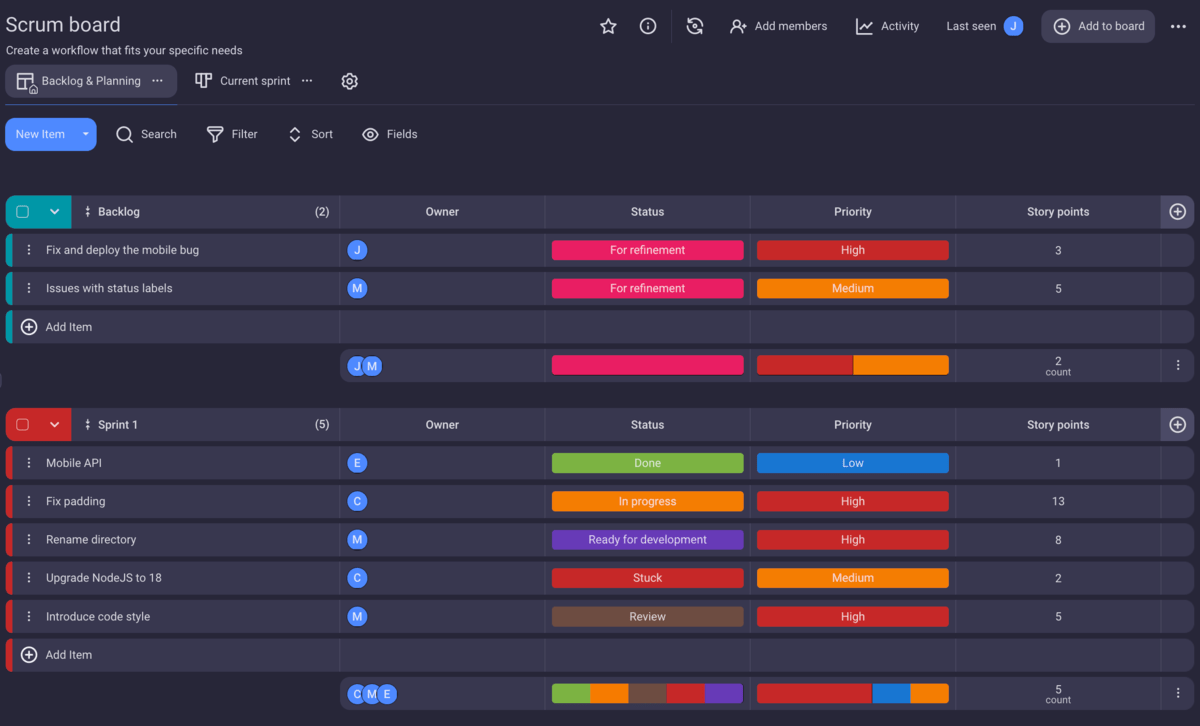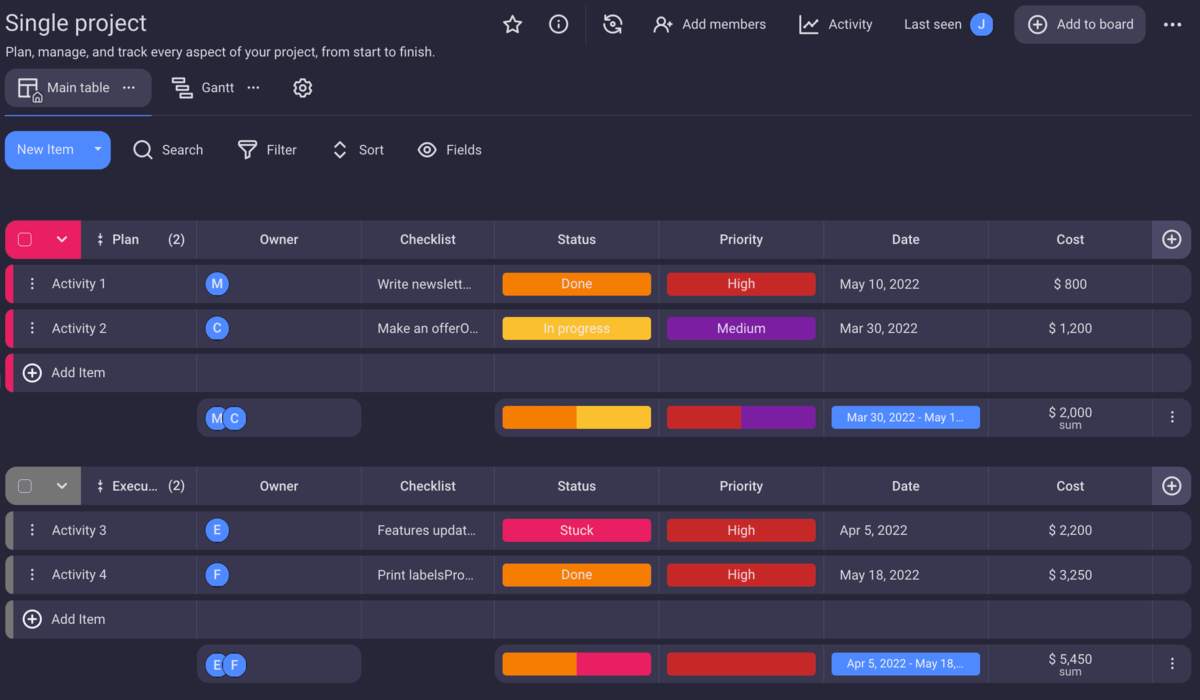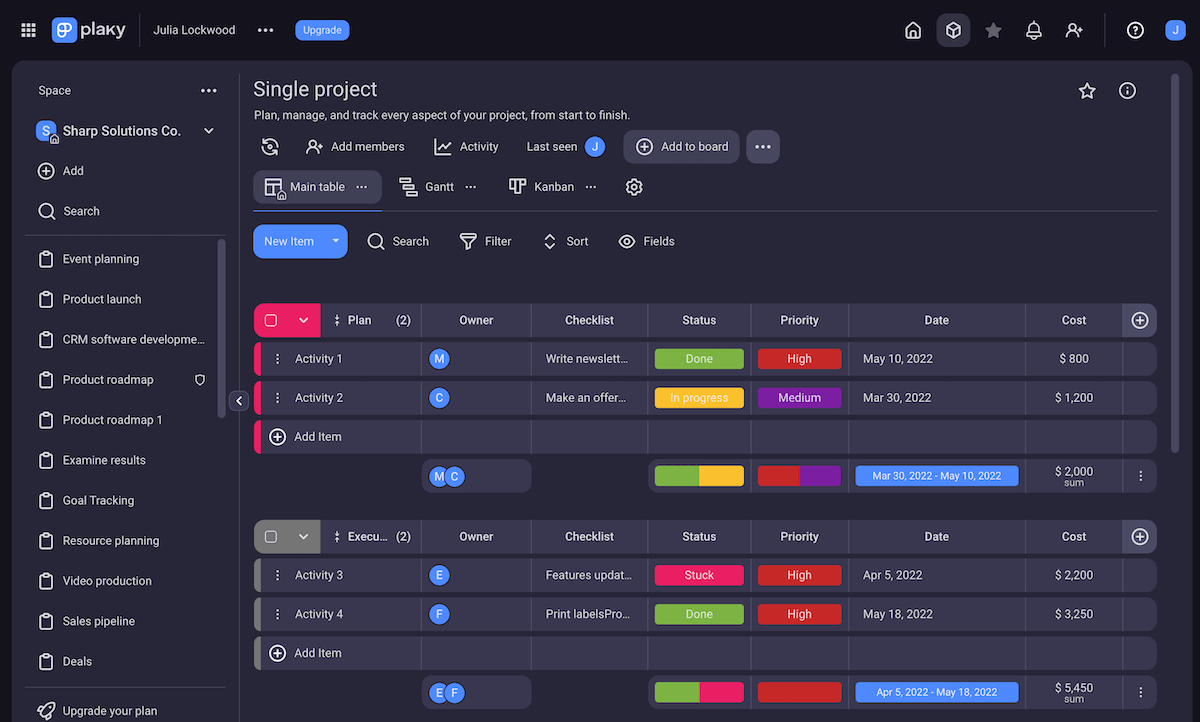What Is a Project Management Office (PMO)?
In the past, organizations questioned the value of the PMO, but the situation has changed — PMOs have become an integral part of many organizations.
The latest project management statistics say that PMOs are on the rise as:
- 89% of organizations claim to have at least 1 PMO, and
- 50% claim to have more than 1 PMO.
And, PMOs are important for a reason — they drive success.
Keep reading, as we’re going to explain why PMOs matter, and cover:
- PMO definition and example,
- PMO structure and types,
- Differences between a PM and a PMO,
- Top-performing PMO activities,
- PMO challenges and best practices, and
- Essential steps for setting up a new PMO.
So, let’s dive in.

Table of Contents
What is a project management office?
The PMBOK® Guide (Seventh edition) defines a PMO as “a management structure that standardizes project-related governance processes and facilitates the sharing of resources, tools, methodologies, and techniques”.
The author of The Complete Project Management Office Handbook, Gerard M. Hill, offers a similar explanation, stating that PMOs integrate 3 factors that influence project performance:
- People (i.e. project stakeholders),
- Processes (i.e. methodologies and practices), and
- Tools (i.e. automated systems and work aids).
The handbook author also claims that the PMO’s role should be to achieve at least 1 of the following project management (PM) objectives:
- Oversight,
- Control, and
- Support.
Based on the PM Solutions research, The State of the Project Management Office (PMO) 2022, we can identify the 6 main benefits of PMOs:
- Improving the quality of deliverables,
- Aligning projects with business objectives,
- Completing more successful projects,
- Delivering projects on budget,
- Delivering projects on time, and
- Improving customer satisfaction.
To sum it up, a PMO is a department that governs and supports all projects and project management activities within an organization to achieve increased business performance.
A real-life PMO example — The National Trust PMO
To help you understand what a PMO looks like in real life, we’ve prepared an example of a PMO that operates within The National Trust.
Andrew Wall, the Head of the PMO at The National Trust, shared his insights in the PMO wisdom interview with Andrew Wall, Summer 2022 for Association for Project Management (APM).
According to Andrew, here’s what the PMO does:
- Runs several of its own projects within the organization,
- Sets the standards for project management across the organization, including the framework, controls and processes, and governance structure,
- Acts as advisor, especially in the early project phases, to help direct the project toward success,
- Provides project, sponsor, client, project management, and program training, and organizes community events,
- Organizes in-house training at various levels, from introductory to practitioner and specific skills training,
- Performs gap analysis on project management staff in terms of skills and maturity, to track and monitor growth,
- Celebrates success and actions that led to successful project outcomes, and
- Prepares projects for senior executive approval.
As we can see from the example, a PMO highly impacts various activities and decision-making processes within an organization.
Altogether, PMO services can contribute to the overall success of an organization.
Who staffs the project management office?
As PMOs significantly differ depending on their type and the organization type, so does their structure.
However, the PMO Competency Framework outlines 4 PMO roles:
- PMO Administrator — supports the team mainly in administrative tasks.
- PMO Analyst — supports the team in coordinating, planning, and analyzing PMO initiatives.
- PMO Manager — manages and supervises all PMO activities and staff, and
- PMO Director — directs at the strategic level and holds accountable for the implementation of the PMO structures across the entire organization.
Regarding their expertise, PM Solutions 2022 PMO research found that the best-performing PMO staff are:
- Highly experienced individuals with 12 years of experience on average, and
- Certified PM professionals (49%).
What is the difference between a PM and a PMO?
People often confuse the terms “PM” and “PMO”.
It is partly because the acronym PMO stands for both:
- Project Management Office — a team of people, and
- Project Management Officer — a single person.
On top of that, PMO may also refer to:
- Program Management Office — a department that governs all programs within a company, and
- Portfolio Management Office — a department that deals with project portfolio management (PPM). This type of PMO governs all the projects and programs within an organization with a focus on the overall financial and strategic goals.
Project management officers often act as connectors between several project managers (PMs) within an organization and usually report directly to the CEO.
5 Types of PMOs
As PMOs vary from one organization to another, there’s still no formalized PMO categorization.
However, the PMO Frameworks Report by PMI managed to provide the 5 general frameworks of PMOs that exist in practice.
PMOs go by several different names but perform similar functions within their companies.
Here are the 5 types of PMOs:
- Departmental PMO, Organizational Unit PMO, Business Unit PMO, or Divisional PMO.
- Project-Specific PMO, Project Office, or Program Office.
- Project Support Office, Services Office, Controls Office, or PMO.
- Enterprise PMO, Organization-wide PMO, Strategic PMO, Corporate PMO, Portfolio PMO, or Global PMO.
- Center of Excellence, or Center of Competency.
Now, let’s further explain these PMO types.
Type #1: Departmental PMO
As its name already suggests, a Departmental PMO supports a specific department within an organization.
According to the PMO Frameworks Report, this type of PMO is the most common, as it’s present in 54% of organizations.
Among other things, Departmental PMOs have the following roles:
- Portfolio management,
- Reporting,
- Governance, and
- Project support.
And, here are the top 3 industries with this type of PMO according to the same research:
- IT,
- Healthcare, and
- Consulting and financial services.
Type #2: Project-Specific PMO
A Project-specific PMO has 2 main characteristics. It is:
- Specific — being established to support a particular project or program.
- Temporary — the lifespan of the PMO and the project are usually the same.
Project-specific PMOs mostly perform the following activities:
- Data management,
- Governance and reporting,
- Administrative activities, and
- Coordination with other PMOs.
These are the top 3 industries with this type of PMO according to the PMO Frameworks report:
- IT,
- Consulting, and
- Telecommunications.
Type #3: Project Support Office
A Project support office supports the daily management of the activities within an organization.
As explained in the Frameworks report, this type of PMO facilitates project delivery by:
- Supporting administrative activities,
- Supporting mentoring, training, and certification activities, and
- Implementing processes, practices, and tools.
These are the top 3 industries with this type of PMO based on the same research:
- IT,
- Government, and
- Manufacturing.
Type #4: Enterprise PMO
The Enterprise PMO is the leading PMO within an organization and is usually responsible for all other lower-level PMOs.
As it operates on the enterprise level, this PMO type holds greater responsibilities, such as:
- Developing corporate strategies,
- Supporting strategic planning,
- Managing multiple stakeholders, and
- Facilitating communication with the stakeholders.
These are the top 3 industries with this type of PMO based on the Frameworks research:
- Financial services,
- IT, and
- Government.
Type #5: Center of Excellence
The primary goal of the Center of Excellence (COE) is to achieve better project delivery.
To do so, COE focuses on various activities that will improve the project delivery process, e.g.:
- Choosing appropriate project management methodologies, standards, and tools,
- Implementing best practices, and
- Providing training and mentoring.
These are the top 3 industries with this type of PMO, based on the Frameworks research:
- Government,
- Manufacturing, and
- Energy.
What does a project management office do?
According to The State of the Project Management Office (PMO) 2022, these are the top 9 activities successful PMOs perform:
- Facilitate the sharing of resources, methodologies, tools, and techniques,
- Enable the consistent use of policies, procedures, and templates,
- Communicate strategic work/progress,
- Standardize project governance processes,
- Align work with strategic goals,
- Implement and manage dashboards and scorecards,
- Establish the just-enough process and practice discipline,
- Collaborate with functional units, and
- Advise and support senior management.
Now, let’s explain the primary PMO responsibilities in more detail.
Activity #1: Facilitate the sharing of resources, methodologies, tools, and techniques
A PMO often helps allocate financial and other resources across multiple projects or tasks.
Proper resource allocation helps achieve successful project delivery and prevents undesired outcomes, such as going over budget.
Also, a PMO ensures that the company uses a suitable project management methodology or framework, e.g.:
Furthermore, a PMO can use different tools and techniques to improve the project workflow.
According to A Project Manager’s Book of Tools and Techniques, here are some of the more common PM techniques:
- Data-gathering techniques (e.g. brainstorming, checklists, benchmarking, etc.)
- Data analysis techniques (e.g. cost-benefit analysis, SWOT analysis, root cause analysis, etc.)
- Data presentation techniques (e.g. flowcharts, mind-mapping, resource breakdown structure, etc.)
- Estimating techniques (e.g. estimate at completion, variance at completion, etc.), and
- Other techniques (e.g. the critical path method, context diagrams, prototypes, rolling-wave planning, etc.).
Activity #2: Enable the consistent use of policies, procedures, and templates
As suggested in the Project Management Academy’s article What Project Managers Need to Know About Policy and Procedure, project teams should always try to adhere to the company’s policies and procedures because:
- It minimizes potential risks as employees work within regulations, and
- It saves time as employees don’t need to learn internal procedures with every new task all over again.
PMOs also facilitate the use of templates, i.e. partially complete documents that provide a defined structure for different project activities.
By using previously tested templates from similar past projects, project teams can increase the efficiency of their current projects.
As a project management tool, Plaky offers many customizable project management templates that can help you kick-start your project regardless of the industry.

Activity #3: Communicate strategic work/progress
According to PM Solutions 2022 PMO research, another PMO activity includes communicating:
- Escalations,
- Project risks, and
- Benefits.
In addition, the PMO Frameworks research found that PMOs’ strategic planning includes activities such as:
- Confirming strategic priorities,
- Defining business goals and aligning them with the strategy,
- Environmental scanning, and
- Opportunity analysis.
Activity #4: Standardize project governance processes
The PM Solutions PMO 2022 research found that high-performing PMOs standardize project governance processes.
As explained in our article on project governance, here are some benefits of project governance:
- It allows proper selection of projects worth investing in,
- It helps define project roles and responsibilities, and
- It supports controlling change in projects.
Activity #5: Align work with strategic goals
According to the PM Solutions 2022 PMO research, many high-performing PMOs align their work with the company’s strategic goals.
As explained in the PMBOK® guide (Seventh edition), holding to your goals is necessary for success as it prevents:
- Gold plating, or
- Scope creep.
So, PMOs should constantly evaluate ongoing projects and offer guidance to the project team.
Activity #6: Implement and manage dashboards and scorecards
Tracking and collecting key performance indicators (KPIs) is an essential part of measuring success, as it provides a clear overview of how the project’s progressing.
However, as highlighted in the PMBOK® Guide (Seventh edition), how you present these metrics is equally important.
A visual display of the project workflow helps present information in a way that makes them “easy to absorb and digest”.
This is why many PMOs use workflow management tools to help them achieve transparency.

Activity #7: Establish the just-enough process and practice discipline
Another important PMO task is to try to contribute to value creation — one of the basic project management principles.
To focus on creating business value in an ever-changing competitive environment, PMOs try to implement simple processes that encourage continuous improvement while minimizing wasteful steps.
Activity #8: Interface with functional units
PMOs often need to collaborate with other functional units within their organizations.
Typical functional units of a company include:
- Finance,
- HR,
- IT,
- Marketing, or
- Sales.
Activity #9: Advise/support senior management
PMOs play an important role in supporting senior management activities — especially change management activities.
According to the Strategic PMOs Play a Vital Role in Driving Business Outcomes report, PMO leaders should have the authority to make necessary changes.
The report explains that, if possible, “PMO leaders should be peers of senior management” who bring organizational value by:
- Thinking strategically,
- Analyzing performance,
- Identifying opportunities, and
- Driving change.
5 Biggest challenges PMOs face
One of the biggest challenges PMOs faced in the past was organizations questioning their value.
The situation has now changed, as PM Solutions PMO 2022 research found that: “The PMO’s value has not been seriously questioned in most organizations (only 18%)”
However, other issues are still present today:
- Poor resource management capability,
- Lack of time/project resources to devote to strategic activities,
- Organizational resistance to change,
- Prioritization of challenges, and
- Not enough project managers.
Luckily, we have useful advice on how they can be solved.
So, keep reading.
Challenge #1: Poor resource management capability
PM Solution 2022 research states that organizations have been facing poor resource management capability issues for the last 20 years.
The prior 2012 Resource Management and the PMO research lists 5 factors affecting poor resource management:
- Too many unplanned requests,
- Unrealistic schedules and project budgets,
- Scope creep,
- Too many pet projects taking the foreground, and
- Poorly defined project deliverables.
What all these factors have in common is poor planning in general.
Our suggestion to overcome these challenges is to improve your planning skills and use technology to assist you, e.g. a project management app.
As there is a strong correlation between the level of resource management maturity and overall organizational performance, organizations should pay attention to proper resource management.
After all, resources lay the foundation for successful projects.
Challenge #2: Lack of time/resources to devote to strategic activities
Apart from not planning resources properly, many organizations face problems with the shortage of resources, including:
- Financial resources,
- Professional human resources,
- Time as a resource, etc.
Strategic PMO activities may be all the actions that lead to strategically important results, such as:
- IT capabilities, or
- New product development.
To achieve those results, PMOs should know how to reserve and allocate available resources.
Challenge #3: Organizational resistance to change
The PMBOK® Guide (Seventh edition) highlights staying relevant in the business environment entails constantly evaluating your offerings and responding to change rapidly.
The guide also states that enabling change is a difficult task for many organizations mainly because they are resistant to change.
As stated in Managing Change in Organizations: A Practice Guide, executives and employees perceive change differently:
- The management sees change as an opportunity for both the business and themselves, while
- Employees see change as stressful, traumatic, and disruptive.
According to the research Identifying and overcoming the challenges of implementing a project management office, there are several solutions to overcoming rigid corporate culture and resistance to change:
- Have a strong PMO champion who strongly advocates PMO values,
- Have a high-level management mandate,
- Start with small changes to demonstrate the benefits of PMO implementations and then proceed with other implementations, and
- Identify the opinion leaders to support the PMO implementations while addressing the individual concerns of those against them.
Implementing a clear and flexible change management strategy is key to overcoming organizational resistance to change.
Also, it is essential to involve employees in the change initiatives and decision-making early on.
The previously mentioned Practice guide lists a few critical success factors for proper change management:
- Effective communication,
- Addressing potential resistance,
- Team collaboration, and
- Active sponsor support.
Challenge #4: Prioritization challenges
According to the study Challenges in Establishing, Managing, and Operating a Project Management Office, accepting ad hoc projects without previous authorization often leads to project failure, mainly due to:
- The lack of available resources, and
- Conflicting priorities.
Often, new urgent projects take priority over those in progress, which can endanger their proper development.
To overcome prioritization issues, PMOs should carefully consider:
- The available resources, and
- The value of each project.
💡 Plaky Pro Tip
Learn more about ad hoc projects and how to handle them in this post:
Challenge #5: Not enough project managers
According to the Challenges of implementing a project management office research, organizations may overcome the lack of experienced PMs and PMO leadership with 3 approaches:
- Bringing in a credible professional to oversee the PMO, somebody who is trusted by the key stakeholders,
- Choosing a professional who has already been employed within the organization, as they will better understand the organizational culture, or
- Bringing in a team of people who are talented and experienced, not necessarily project managers, but who have been in the organization for quite some time and have the necessary project management skills.
💡 Plaky Pro Tip
If you want to read more about how to gain more project management experience, check out this blog:
4 Best practices of PMO
Following a few best practices can have positive results on the overall PMO performance.
Here are the 4 best practices we recommend:
- The use of software,
- Trained staff,
- Proper resource management, and
- Adherence to PM principles.
Keep reading to find out more about the best practices.
Best practice #1: The use of software
Strategic PMOs Play A Vital Role In Driving Business Outcomes research outlines that a successful PMO should invest in tools that bring transparency to how people work.
The research states that using centralized tools that offer reliable data and enable early visibility into performance trends directly supports proactive decision-making.
Here’s an example of how a PMO can use a centralized Plaky project management software for governance:

As you can see, the Plaky project management tool allows tracking all your projects and activities in one place.
With Plaky, you can increase the PMO efficiency with features such as:
- Task management — you can group your tasks and label them according to the assignee, type, priority, status, due date, etc.
- Team collaboration — you can stay up to date on who’s doing what, tag your teammates in the comments section, share files with them, notify them of any changes, etc.
- Progress checking — you can track the progress of all your projects in real-time.
And what’s more, you can add as many different spaces as you want and customize them based on your personal preferences.
As found in the Strategic PMOs research, it’s difficult to make proper strategic decisions without objective data.
A tool such as Plaky prevents the information from being scattered across the organization and gives an objective view of all project information.
Best practice #2: Trained staff
As the 2013 APQC Best Practices Study on Effective PMOs found, the best-practice organizations, such as Dell, usually offer:
- Soft skills training,
- Coaching and mentoring from senior PMs, and
- PM-specific content to all employees.
A more recent 2022 PM Solutions report confirms that training remains an essential trait of high-performing PMOs.
To be more precise, 97% of high-performing PMOs offer project management-related training.
Here’s the table showing the training course types successful PMOs offer, as found by PM Solutions:
| Training course type offered by high-performing PMOs | Percentage of PMOs offering each course type |
|---|---|
| Project Management Basics | 76% |
| Leadership Training | 55% |
| Advanced PM Skill Development | 48% |
| Business Alignment Training | 48% |
| Agile Project Management | 45% |
| PMP Preparation | 41% |
| Change Management | 38% |
| PM Software Tool Training | 38% |
The same report states that high-performing organizations offer:
- More kinds of training,
- More days of training, and
- More advanced topics.
Regardless of the PMO size, more training results in better performance.
Best practice #3: Proper resource management
The PM Solutions research found that:
High-performing PMOs are more likely to use contracted resources to help in managing projects than low-performing PMOs (72% vs. 43%).
Hiring outside experts has proved to be a good practice that brings positive results to project delivery.
Contracted resources are a common practice in energy/utility organizations where:
- More than 90% of PMOs use contracted resources to manage projects and programs, and
- More than 40% of PMOs use contracted resources to manage their PMO functions.
Best practice #4: Adherence to PM principles
The PM Solutions 2022 study found that, generally, PMOs adhere to basic project management principles.
Here are the 12 fundamental PM principles in short:
- Being respectful and caring,
- Creating a collaborative environment,
- Engaging with stakeholders,
- Focusing on value,
- Responding to system interactions,
- Being a good leader,
- Tailoring,
- Focusing on quality,
- Navigating complexity,
- Managing risks,
- Being flexible, and
- Enabling change.
The PM principles may serve as guidelines, as following them, directly or indirectly, leads to project success.
📖 PMO is just one of the many acronyms that project workers are expected to understand. If project management terminology is still new to you, we recommend checking out our Project Management Glossary of Terms where you can learn all about basic and advanced project management terms.
How to set up a PMO in 4 steps
In this part, we’ll guide you through 4 essential steps to focus on when building a new or smaller PMO, as explained in The Complete Project Management Office Handbook:
- Develop a PMO charter,
- Identify the PMO sponsor and establish an executive control board
- Develop the project classification scheme, and
- Align with other organizational units.
So, let’s cover the specifics.
Step #1: Develop a PMO charter
Developing a PMO charter is one of the initial steps in building a new PMO, as it outlines its:
- Purpose — how the PMO contributes to improved business performance,
- Organizational alignment — how the PMO relates to other business units,
- Function — what activities the PMO performs,
- Authority — what authorities the PMO has, and
- Funding — what the PMO budget is.
The PMO Handbook also highlights that the PMO charter is a “living” document — you can update it with any occurred changes.
After you’ve got your PMO charter ready, it needs to be approved by the highest executive level.
💡 Plaky Pro Tip
To learn more about the project charter, read this guide:
Step #2: Identify the PMO sponsor and establish an executive control board
According to the PMO Handbook, a PMO must have an executive sponsor. If possible, the sponsor is the most senior person within the organization.
Also, new and small PMOs should establish an executive control board, with the executive sponsor as its key member.
This team will provide the PMO with the necessary business guidance and direction.
Step #3: Develop the project classification scheme
The purpose of the project classification scheme is to specify the project types the PMO oversees.
The PMO Handbook classifies projects based on 4 factors:
- Business interest — whether it is a base, tactical, growth, or strategic project,
- Project size — whether it is a small, medium, intermediate, or large project based on labor hours, people involved, and duration.
- Project value — whether it is a low, moderate, intermediate, or high-value project based on its estimated cost.
- Project complexity — based on the number of business units involved and technology, risk, and strategic importance factors.
Step #4: Align with other organizational units
PMOs’ daily activities often include interaction with other business and technical committees.
To get the necessary information and guidance from these committees, PMOs should:
- Identify business and technical groups,
- Set up relationships with them, and
- Manage those relationships.
By understanding other committees’ business needs and interests, PMOs can implement those needs into project management practices.
PMOs are on the rise as they are proven to bring results
If you’ve ever doubted PMOs’ importance, we’re sure that this guide has made it clear that PMOs can steer organizations toward success.
PMOs support their companies in various project management activities and can facilitate critical decision-making.
What’s more, PMOs:
- Guide,
- Educate, and
- Support change.
Admittedly, PMOs still have a few challenges to face.
However, the trend that they will keep proving their great value in the future is positive.
References
- APQC Best Practices Study on effective project management offices shows that “You get what you measure”. (2013). Retrieved February 8, 2023, from https://www.apqc.org/about-apqc/news-press-release/apqc-best-practices-study-effective-project-management-offices-shows
- Dionisio, C. S. (2018). A Project Manager’s Book of Tools and Techniques: A companion to the PMBOK guide. Hoboken: Wiley.
- Hill, G. M. (2007). Complete Project Management Office Handbook. Auerbach Publications.
- Managing change in organizations: A practice guide. (2013). Project Management Institute.
- PMO frameworks report | PMI Pulse of Profession. Retrieved February 8, 2023, from https://www.pmi.org/-/media/pmi/documents/public/pdf/learning/thought-leadership/pulse/pmo-frameworks.pdf?v=0e51511c-12d6-4afa-bb0d-967c1e82ce71&sc_lang_temp=en
- PMO Learning and PMO training for PMO professionals. Available at: https://www.pmolearning.co.uk/
- Roden, E. J. (2021). The PMO Competency Framework. GB: House of PMO.
- Salamah, H., & Alnaji, L. (2014). Challenges in Establishing, Managing, and Operating a Project Management Office. Retrieved from https://www.researchgate.net/publication/261358236_Challenges_in_Establishing_Managing_and_Operating_a_Project_Management_Office.
- Singh, R., Keil, M., & Kasi, V. (2009). Identifying and overcoming the challenges of implementing a Project Management Office. European Journal of Information Systems, 18(5), 409-427. doi:10.1057/ejis.2009.29
- Strategic PMOs Play a Vital Role in Driving Business Outcomes. (2013). Forrester Consulting. Retrieved February 8, 2023, from https://www.pmi.org/-/media/pmi/documents/public/pdf/learning/thought-leadership/forrester-pmos-play-vital-role.pdf?rev=ed3281c3081b4bb09cdedb7a5b29bbb0
- The standard for Project Management: A guide to the Project Management Body of Knowledge (PMBOK® Guide). (2021). PMI.
- The state of the PMO 2022. PM Solutions. Retrieved January 24, 2023, from https://www.pmsolutions.com/resources/view/the-state-of-the-pmo-2022/
- Wall, A. (2022). PMO wisdom interview with Andrew Wall, Summer 2022 [Interview]. Retrieved February 8, 2023, from https://www.apm.org.uk/news/pmo-wisdom-interview-with-andrew-wall-summer-2022/
- What Project Managers Need to Know About Policy and Procedure. (2020). Project Management Academy. Retrieved February 8, 2023, from https://projectmanagementacademy.net/resources/blog/what-project-managers-need-to-know-about-policy-and-procedure/#policy
- White Paper Resource Management and the PMO – PM Solutions. (2012). Retrieved February 8, 2023, from https://www.pmsolutions.com/white_papers/White_Paper_Resource_Management_and_the_PMO_2012.pdf
 Project Management Hub
Project Management Hub 











